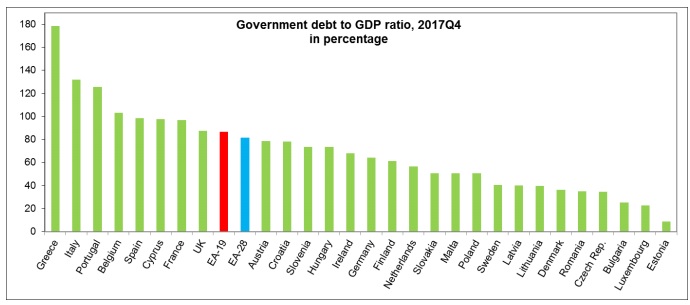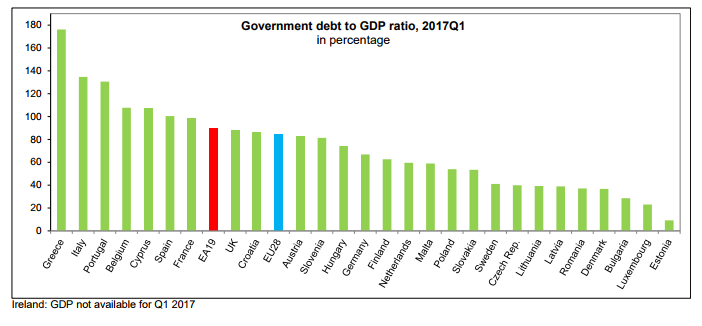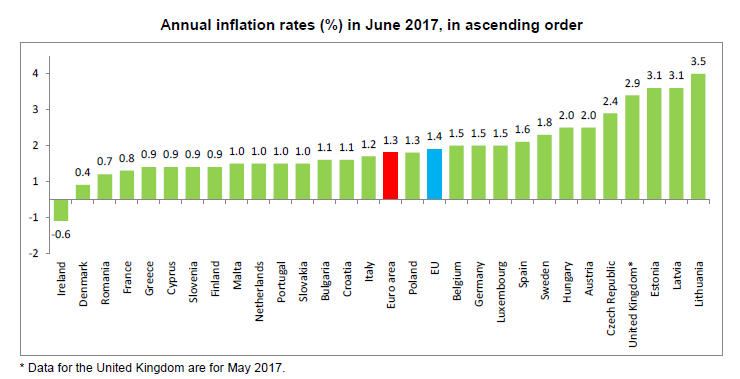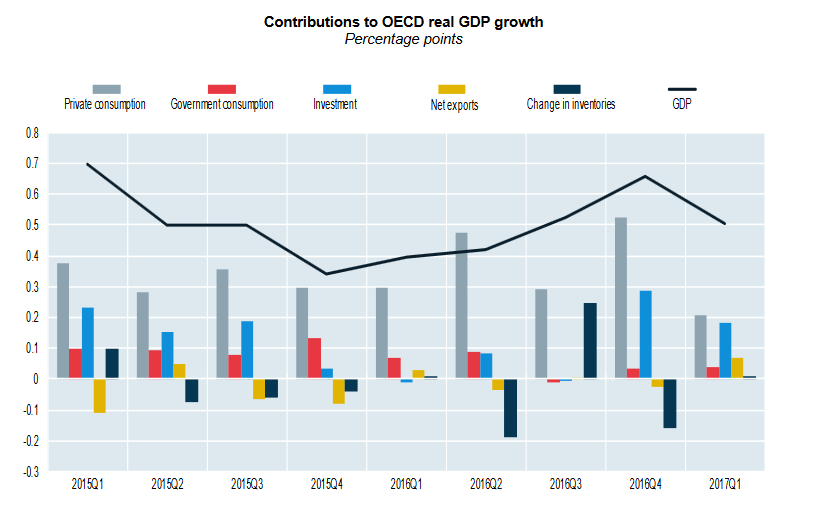Euro area economic and financial developments by institutional sector: fourth quarter of 2017, 27 Απριλίου 2018 Euro area saving (net, as a percentage of disposable income) was higher in the fourth quarter of 2017 than in the same quarter of the previous year. Total euro area non-financial investment (net) increased owing to higher investment by households and non-financial corporations (NFCs). Euro area net lending to the rest of the world …Read More
Government debt fell to 86.7% of GDP in euro area
Eurostat/Government debt fell to 86.7% of GDP in euro area/24 Απριλίου 2018 At the end of the fourth quarter of 2017, the government debt to GDP ratio in the euro area (EA19) stood at 86.7%, compared with 88.1% at the end of the third quarter of 2017. In the EU28, the ratio also decreased from 82.4% to 81.6%. Compared with the fourth quarter of 2016, the government debt to GDP …Read More
Government debt up to 89.5% of GDP in euro area
Eurostat/Government debt up to 89.5% of GDP in euro area/20 Ιουλίου 2017 At the end of the first quarter of 2017, the government debt to GDP ratio in the euro area (EA19) stood at 89.5%, compared with 89.2% at the end of the fourth quarter of 2016. In the EU28, the ratio also increased from 83.6% to 84.1%. Compared with the first quarter of 2016, the government debt to GDP …Read More
The Re-Emerging Privilege of Euro Area Membership
Wiegand, Johannes, (2017), “The Re-Emerging Privilege of Euro Area Membership”, IMF Working Paper No. 17/162, 18 Ιουλίου When the euro was introduced in 1998, one objective was to create an alternative global reserve currency that would grant benefits to euro area countries similar to the U.S. dollar’s “exorbitant privliege”: i.e., a boost to the perceived quality of euro denominated assets that would increase demand for such assets and reduce euro …Read More
Euro area international trade in goods surplus €21.4 bn
Eurostat/Euro area international trade in goods surplus €21.4 bn/14 Ιουλίου 2017 The first estimate for euro area (EA19) exports of goods to the rest of the world in May 2017 was €189.6 billion, an increase of 12.9% compared with May 2016 (€167.8 bn). Imports from the rest of the world stood at €168.1 bn, a rise of 16.4% compared with May 2016 (€144.4 bn). As a result, the euro area …Read More
EU Foreign Direct Investment flows
Eurostat, (2017), “EU Foreign Direct Investment flows”, 18 Ιουλίου According to preliminary results, Foreign Direct Investment (FDI) from the European Union (EU) to the rest of the world amounted to €186 billion in 2016, a sharp drop (-68%) compared with the €585 bn recorded in 2015. In the opposite direction, investment from the rest of the world into the EU stood at €280 bn, down by 41% compared with 2015 …Read More
Annual inflation down to 1.3% in the euro area
Eurostat/Annual inflation down to 1.3% in the euro area/17 Ιουλίου 2017 Euro area annual inflation was 1.3% in June 2017, down from 1.4% in May. In June 2016 the rate was 0.1%. European Union annual inflation was 1.4% in June 2017, down from 1.6% in May. A year earlier the rate was 0.1%. These figures come from Eurostat, the statistical office of the European Union. The lowest annual rates were …Read More
The effectiveness of unconventional monetary policy on risk aversion and uncertainty. For an optimal use of economic policy framework – priority to financial union
Rompolis, Leonidas S., (2017), “The effectiveness of unconventional monetary policy on risk aversion and uncertainty. For an optimal use of economic policy framework -priority to financial union“, Bank of Greece, Working Paper 231, Ιούνιος This paper examines the impact of unconventional monetary policy of ECB measured by its balance sheet expansion on euro area equity market uncertainty and investors risk aversion within a structural VAR framework. An expansionary balance sheet …Read More
Contributions to GDP growth: first quarter 2017, Quarterly National Accounts
OECD/Contributions to GDP growth: first quarter 2017, Quarterly National Accounts/6 Ιουλίου 2017 Real GDP in the OECD area increased by 0.5% in the first quarter of 2017, compared with 0.7% in the previous quarter, according to provisional estimates, mainly reflecting reduced contributions from private consumption (0.2 percentage point against 0.5 in the previous quarter) and investment (0.2 percentage point against 0.3). Net exports provided an additional 0.1 percentage point to …Read More
The international role of the euro
European Central Bank (ECB), (2017), “The international role of the euro”, Annual Review, Ιούλιος This report covers developments in 2016 and early 2017. This period was characterised by heightened non-economic risks stemming in particular from geopolitical developments, elections in some euro area countries, economic policy uncertainty in the wake of the outcome of the United Kingdom’s referendum on EU membership and the arrival of a new US administration, as well …Read More










